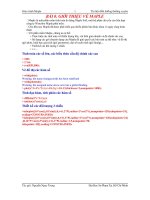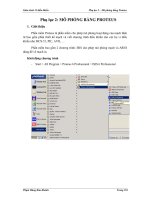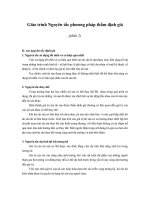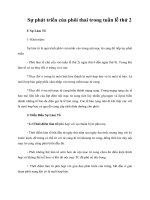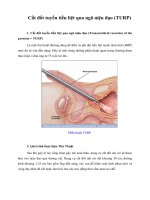Tài liệu Giáo trình Auto-PEEP ppt
Bạn đang xem bản rút gọn của tài liệu. Xem và tải ngay bản đầy đủ của tài liệu tại đây (415.99 KB, 9 trang )
CLEVELAND CLINIC JOURNAL OF MEDICINE VOLUME 72 • NUMBER 9 SEPTEMBER 2005
801
MAJID M. MUGHAL, MD
Assistant Professor of Medicine, University of South Alabama
Medical Center, Mobile
OMAR A. MINAI, MD
Department of Pulmonary, Allergy, and Critical Care Medicine,
The Cleveland Clinic Foundation
DANIEL A. CULVER, DO
Department of Pulmonary, Allergy, and Critical Care Medicine,
The Cleveland Clinic Foundation
ALEJANDRO C. ARROLIGA, MD
Professor of Medicine, Cleveland Clinic Lerner College of
Medicine of Case Western University; Head, Section of Critical
Care Medicine, Department of Pulmonary, Allergy, and Critical
Care Medicine, The Cleveland Clinic Foundation
Auto-positive end-expiratory pressure:
Mechanisms and treatment
REVIEW
■ ABSTRACT
Auto-positive end-expiratory pressure (auto-PEEP) is a
common problem in patients receiving full or partial
ventilatory support, as well as in those ready to be
weaned from the ventilator. Physicians should be alert for
it and take measures to reduce it, as it can have serious
consequences.
■ KEY POINTS
Auto-PEEP occurs much more frequently than was
previously thought.
Auto-PEEP and dynamic hyperinflation may cause
significant discomfort and precipitate patient-ventilator
asynchrony through several mechanisms.
Auto-PEEP increases the work of breathing and can
worsen gas exchange and decrease cardiac output.
In some patients with auto-PEEP due to airflow
obstruction and dynamic hyperinflation, external PEEP
may be used to decrease the work of breathing and
relieve dyspnea.
UTO
-
POSITIVE END
-
EXPIRATORY PRESSURE
(auto-PEEP), a common problem in
patients receiving mechanical ventilation,
can have serious consequences. The clinician
needs to fully understand the physiology of
auto-PEEP so as to choose appropriate venti-
lator settings.
Why should generalists think about
mechanical ventilation? A recent study
showed that intensivists care for only 36.8%
of critically ill patients in the United States,
while general internists, surgeons, and anes-
thesiologists manage the rest.
1
The incidence
of acute respiratory failure requiring mechani-
cal ventilation increases nearly 10-fold
between the ages of 55 and 85 years.
2
With
the aging of the population, even more gener-
alists will likely care for these patients in the
future, and it is necessary for them to under-
stand the important elements of managing
patients on mechanical ventilation.
This review, part of a series of articles cov-
ering topics in mechanical ventilation pub-
lished in this journal,
3–5
provides an overview
of auto-PEEP.
■ WHAT IS AUTO-PEEP?
Positive end-expiratory pressure (PEEP) is
defined as pressure in the alveoli at the end of
exhalation that is greater than the atmospher-
ic pressure.
Normally, during passive exhalation, the
lungs empty by elastic recoil, and at the end of
exhalation the alveolar pressure is the same as
the atmospheric pressure. However, for sever-
al reasons, the lungs may not deflate fully
before the next breath starts, and the pressure
remains elevated. PEEP can be applied inten-
A
802
CLEVELAND CLINIC JOURNAL OF MEDICINE VOLUME 72 • NUMBER 9 SEPTEMBER 2005
tionally from the outside, but when it arises
inadvertently it has been called auto-PEEP,
occult PEEP, or intrinsic PEEP.
6,7
Mechanical causes of auto-PEEP in a pas-
sive respiratory system are:
• Increased resistance to expiration, eg, in a
patient with asthma or chronic obstruc-
tive pulmonary disease (COPD)
•A large volume of air delivered per minute
by the ventilator
•A short expiratory time
•A combination of these factors.
■ WHO DEVELOPS AUTO-PEEP?
Auto-PEEP is more common than previously
thought in critically ill, mechanically ventilat-
ed patients. Unexpected auto-PEEP occurs in
up to 35% of patients even when there is no
significant history of wheezing or COPD.
8
Auto-PEEP should be anticipated in
patients with respiratory failure due to
obstructive lung disease. Patients with an
exacerbation of COPD who require intuba-
tion and mechanical ventilation frequently
develop dynamic hyperinflation from
impaired lung-emptying due to a limitation of
expiratory flow, resulting in auto-PEEP.
7,9
However, auto-PEEP and dynamic hyper-
inflation may also occur without any intrinsic
limitation on expiratory flow,
10
and auto-
PEEP is not uncommon in ventilated patients
with sepsis, respiratory muscle weakness,
8
or
the adult respiratory distress syndrome.
11
■ THREE TYPES OF AUTO-PEEP
Three types of auto-PEEP can occur in
patients on mechanical ventilation, each with
a different cause and consequences (
TABLE 1
).
10
Dynamic hyperinflation
with intrinsic expiratory flow limitation
The main cause of auto-PEEP in patients with
COPD on mechanical ventilation is closure of
the airways, which limits expiratory flow.
12
In COPD, the alveolar attachments that
normally keep the smaller airways open via
radial traction are lost. Consequently, during
exhalation, when the pleural pressure is posi-
tive, these airways can be compressed and col-
lapse. The flow of air during expiration is
therefore limited and cannot be augmented by
effort, resulting in auto-PEEP and dynamic
hyperinflation.
12
This condition can be helped by applying
external PEEP (
FIGURE 1
).
Dynamic hyperinflation
without expiratory flow limitation
Auto-PEEP can also occur even if the airways
are widely patent without intrinsic expiratory
flow limitation. This may occur if the volume of
air delivered per minute is high (usually > 20
L/minute), if the exhaled time is too short to
allow exhalation to functional residual capacity,
or if exhalation is impeded by a blockage exter-
nal to the patient, such as a blocked endotra-
cheal tube, exhalation valve, or PEEP valve.
10
Under such circumstances, external PEEP
would not be beneficial because it would
impose a back pressure to expiratory airflow,
causing parallel increases in lung volume and
airway, alveolar, and thoracic pressures.
10
Exaggerated expiratory activity
without dynamic hyperinflation
Although auto-PEEP and dynamic hyperinfla-
tion are usually thought to be synonymous,
auto-PEEP does not necessarily imply dynam-
ic hyperinflation. Auto-PEEP may also occur
when strong expiratory muscle activity con-
Auto-PEEP
should be
anticipated in
exacerbations
of COPD
AUTO-PEEP MUGHAL AND COLLEAGUES
Physiologic mechanisms of auto-positive
end-expiratory pressure
Dynamic hyperinflation
plus intrinsic expiratory flow limitation
Chronic obstructive pulmonary disease
Dynamic hyperinflation
without intrinsic expiratory flow limitation
Breathing pattern and ventilator settings
Rapid breaths
High tidal volume
Inspiration greater than expiration
End-inspiratory pause
Added flow resistance
Fine-bore endotracheal tube
Ventilator tubing and devices
Without dynamic hyperinflation
Recruitment of expiratory muscles
T ABLE 1
CLEVELAND CLINIC JOURNAL OF MEDICINE VOLUME 72 • NUMBER 9 SEPTEMBER 2005
803
FIGURE 1
CCF
©2005
■ Auto-PEEP in chronic obstructive pulmonary disease
Auto-positive end-expiratory pressure (auto-PEEP) is common in patients with respiratory
failure due to obstructive lung disease who require intubation and mechanical ventilation.
Causes: obstruction (the most common cause, shown here), rapid breathing, large volumes
of air, and exaggerated expiratory effort.
Air is trapped
in auto-PEEP
In auto-PEEP, alveoli
remain inflated at
end-expiration due
to obstruction, so
alveolar pressure
is greater than
atmospheric
pressure. In the
absence of
inspiratory
effort,
intrapleural
pressure
approximates
alveolar pressure.
Auto-PEEP increases
the work of breathing
To overcome the positive
pressure in the alveoli
during inspiration,
the diaphragm must
generate enough
negative pressure to
exceed the auto-PEEP
and transmit negative
pressure to the central
airways, generating
airflow.
External PEEP
treats auto-PEEP
The positive pressure of external
PEEP eases the amount of work
the diaphragm must do to draw
air in, by allowing small negative
deflections in intrapleural pressure
to be sensed by the ventilator when
the patient tries to trigger a breath.
Obstructive
airway
Alveolar pressure
–
1 cm H
2
O
0 cm H
2
O
+ 10
cm H
2
O
+ 10
cm H
2
O
+ 9
cm H
2
O
+ 8
cm H
2
O
+
6 cm H
2
O
–
13 cm H
2
O
–
3 cm
H
2
O
+ 10 cm H
2
O
Pleural pressure
804
CLEVELAND CLINIC JOURNAL OF MEDICINE VOLUME 72 • NUMBER 9 SEPTEMBER 2005
tributes to alveolar pressure, often with nor-
mal or even low lung volumes. If the flow per-
sists to the end of the expiratory cycle, there
will be an end-expiratory gradient of alveolar
to central airway pressure—an auto-PEEP
effect without lung distention.
13,14
This auto-
PEEP phenomenon is due to dynamic airway
collapse with exaggerated expiratory activity.
Zakynthinos et al
15
demonstrated that in
intubated patients who are spontaneously
breathing and actively exhaling, auto-PEEP
due to expiratory muscle contraction can be
estimated by subtracting the average expirato-
ry rise in gastric pressure from the end-expira-
tory airway pressure during airway occlusion.
■ CONSEQUENCES OF AUTO-PEEP
Increases the work of breathing
Auto-PEEP causes a considerable increase in
the resistive and elastic work of breath-
ing,
16,17
which may interfere with attempts at
weaning from mechanical ventilation.
18
This
can cause significant discomfort and precipi-
tate patient-ventilator asynchrony.
Worsens gas exchange
Brandolese et al compared the impact of auto-
PEEP and external PEEP on pulmonary gas
exchange in mechanically ventilated patients.
19
Arterial oxygen tension was lower in patients
Auto-PEEP
is measured
by occluding
the airway at
end-expiration
for several
seconds
0
+
Airway
pressureFlow
Volume
increasing
inout
-
0
0
02468101214
Valve closed
Valve open
Valve closed
Valve open
Valve closed
Valve open
16
Estimating auto-positive end-expiratory pressure (auto-PEEP)
FIGURE 2. Expiratory hold techniques to estimate auto-PEEP. The exhalation valve is
closed during an expiratory hold at the end of the set expiratory time. When the
flow equals zero, airway pressure rises to the auto-PEEP level. With the valve open,
flow continues, and the additional exhaled volume equals the volume of trapped gas.
MACINTYRE NR. INTRINSIC PEEP. PROB RESPIR CARE 1991; 4:45, WITH PERMISSION.
AUTO-PEEP MUGHAL AND COLLEAGUES
with auto-PEEP than in patients with a compa-
rable level of external PEEP, an effect the
authors attributed to a less homogenous distrib-
ution of auto-PEEP among lung units.
Can cause hemodynamic compromise
Auto-PEEP also has hemodynamic conse-
quences. Elevated intrathoracic pressure
reduces the preload of the right and left ven-
tricles, decreases left ventricular compliance,
and can increase right ventricular afterload by
increasing pulmonary vascular resistance. This
can lead to hemodynamic compromise.
12,20
In a dog model described by Marini et al,
21
selective hyperinflation of the lower lobes
(particularly the right lower lobe) or any dis-
tention of lung tissue adjacent to the right side
of the heart was associated with decreased
stroke volume. The decrease in stroke volume
was more closely related to an increase in right
atrial pressure than in left atrial pressure,
implying that impaired venous return was the
dominant cause of reduced cardiac output.
This mechanism is likely the cause of hypoten-
sion in patients with inadvertent PEEP.
Hemodynamic effects of auto-PEEP
should be considered as a possible reversible
cause of pulseless electrical activity. In one
report,
22
auto-PEEP may have played a part in
up to 13 (38%) of 34 patients with electro-
mechanical dissociation.
During cardiopulmonary resuscitation,
dynamic hyperinflation can develop in
patients with obstructive airway disease,
owing to rapid manual ventilation with inad-
equate time for exhalation. This elevated
end-expiratory pressure (auto-PEEP) decreas-
es venous return and may depress cardiac out-
put even after a cardiac rhythm has been
established. Transient withdrawal of ventila-
tion allows the dynamic hyperinflation to
diminish, reducing intrathoracic pressure and
permitting the return of spontaneous circula-
tion.
Can lead to inappropriate treatment
Failure to recognize auto-PEEP and adjust for
it can lead to inappropriate treatment in sev-
eral ways:
• Misinterpretation of central venous and
pulmonary artery catheter pressure mea-
surements
12
: the auto-PEEP-induced
increase in intrathoracic pressure may
falsely increase the pulmonary capillary
wedge pressure and right atrial pressure,
which can lead to mistakes in hemody-
namic management.
• Erroneous calculations of static respirato-
ry compliance: the true value of static
compliance will be underestimated in the
presence of auto-PEEP.
19
• Inappropriate fluid administration or
unnecessary vasopressor therapy.
■ RECOGNIZING AUTO-PEEP
Four practical clues may suggest the diagnosis
of auto-PEEP:
• Exhalation that continues until the next
breath starts, as determined on physical exam-
ination
23
or on graphic display of expiratory
flow vs time in a patient on a ventilator that
is set to deliver a certain number of breaths
per minute
•A delay between the start of inspiratory
effort and the drop in airway pressure or the
start of machine-delivered flow in a patient on
a ventilator that is set to deliver breaths on
demand
• Failure of peak airway pressure to change
when external PEEP is applied
• In paralyzed or heavily sedated patients,
reduction of plateau pressure after prolonged
exhalation.
■ HOW TO MEASURE AUTO-PEEP
Static auto-PEEP. Auto-PEEP can be
accurately measured only in patients without
active respiratory effort. It is routinely deter-
mined under static conditions by occluding
the airway at end-exhalation. During con-
trolled mechanical ventilation, reliable quan-
tification of auto-PEEP requires an end-expi-
ratory hold maneuver, terminating expiratory
flow and allowing equilibration of alveolar
pressure and the airway pressure (
FIGURE 2
). The
resulting airway pressure represents the aver-
age total PEEP present within a nonhomoge-
neous lung, and auto-PEEP is calculated by
subtracting external PEEP from total PEEP.
Dynamic auto-PEEP. There is no accept-
ed, reliable method to measure auto-PEEP in
spontaneously breathing patients. However,
CLEVELAND CLINIC JOURNAL OF MEDICINE VOLUME 72 • NUMBER 9 SEPTEMBER 2005
805
Suspect
auto-PEEP
if exhalation
continues
until the next
breath starts
